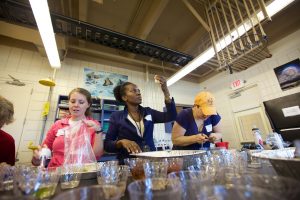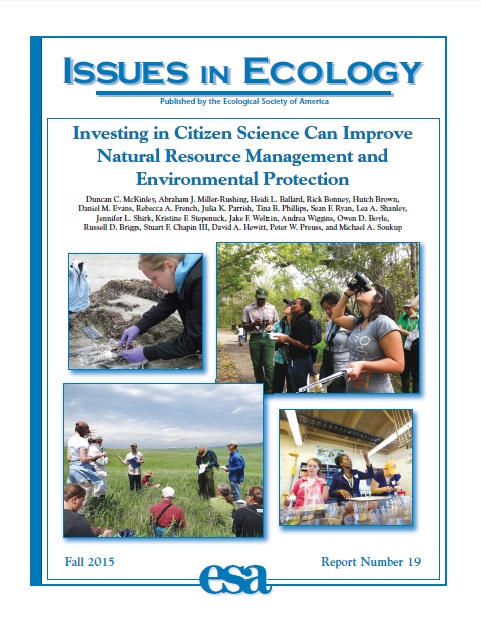Expanding the reach of environmental research with Citizen Science
Issues in Ecology 19: Investing in Citizen Science can improve natural resource management and environmental protection
FOR IMMEDIATE RELEASE: Wednesday, 30 September 2015
Contact: Liza Lester, 202-833-8773 ext. 211, gro.asenull@retseLL

Growth in the number of scientific publications that have used or studied citizen science since 1995. Data are based on a search of the Web of Science for the keyword “citizen science” and likely represent a fraction of all scientific publications using or studying citizen science because many publications fail to acknowledge when they include contributions from citizen science. Fig 1 of McKinley et al (2015) Issues in Ecology 19.
Public participation in scientific research has surged in popularity and prominence in recent years through the connections of the world wide web, an explosion of smartphone pocket computing power, and a slow cultural change within professional science toward a more open and welcoming research environment.
Today, the White House affirmed the potential for citizen science to engage the public directly in scientific discovery and the monitoring and management of our natural resources. In a memorandum to the heads of executive departments and agencies, Director of the Office of Science and Technology Policy John Holdren mandated that all federal agencies build capacity for citizen science and crowdsourcing while facilitating cooperation across agencies and with outside organizations.
To help guide program managers in deciding if citizen science is right for their organizations and how best to design citizen science projects to meet their organization’s goals, the Ecological Society of America (ESA) has released a report today summarizing how “Investing in Citizen Science can improve natural resource management and environmental protection.” The report is number 19 in ESA’s series Issues in Ecology and is included as a resource in the Federal Citizen Science and Crowdsourcing Toolkit, released this morning in conjunction with Holdren’s policy memo and a Citizen Science Forum webcast live from the White House.
“If you ask a dozen practitioners about citizen science, you’ll get a dozen different definitions, and a dozen reasons for why they are doing it—all of which are valid! But it can be confusing,” said Duncan McKinley, a research ecologist with the USDA Forest Service and a lead coordinator of the scientific team behind the report. “We wanted to zoom out to the big picture, the 30,000-ft view of citizen science, and capture the shared values of the field, within the specific context of ecology and the environment.”
The report touches on how citizen science can help organizations:
- Meet core information needs for research and monitoring
- Promote environmental stewardship
- Foster public involvement in environmental decision-making
- Spread knowledge and scientific literacy
- Encourage collaboration
- Address questions of local concern
- Expand awareness of an organization’s mission
- Ignite synergies between science, education, and public engagement
Twenty-one experienced practitioners hailing from non-profit, government, and academic institutions set out to tame the exuberant diversity of the citizen science frontier into shared core principles. The report delves into the strengths and limitations of citizen science, illustrating the breadth of existing applications through case studies. The authors identify hallmarks of research questions ripe for volunteer involvement as well as those that might not be appropriate for a citizen science approach.
“Citizen science is not fluff science,” said report co-organizer Abe Miller-Rushing, science coordinator for Acadia National Park and the Schoodic Education and Research Center. “Citizen science has a strong reputation for education and outreach, but its ability to deliver actionable information is underrated.”

Volunteers for Smithsonian’s Biocube project sort and identify specimens for a biodiversity survey. Modeled on the classic ecologist’s quadrat, which marks out a standard sampling plot, Biocube guides observers to catalog the variety of life found in one cubic foot of soil or seawater. Credit, Carolyn A. F. Enquist.
Citizen science has earned a reputation for excellence in advancing science literacy at all ages and educational levels. With this report, Miller-Rushing, McKinley, and co-authors hope to demonstrate that citizen science also has the tools to produce high quality data. Citizen science projects have produced rigorous science on par with conventional research produced entirely by professional scientists. Data gathered by observers for the North American Breeding Bird Survey, for example, have contributed to more than 500 peer reviewed papers.
Participation in research makes abstract concepts concrete—and fun. Participants say they are motivated by opportunities to contribute information that will be used in the conservation of organisms, ecosystems, or natural areas that they care about.
“Hands-on involvement in a real research question makes science tangible and lends participants a sense of personal connection to our natural resources,” said author Heidi Ballard, an associate professor in the School of Education at the University of California, Davis.
But citizen science is not just an individual or personal activity; it is often undertaken in groups. Local communities and environmental organizations have been involved in monitoring local natural resources for many years. In some cases, local communities have actually driven the development of a research initiative through acute concerns about water or air quality in their region. Participation in citizen science generates greater participation in public decision-making, with some projects providing direct means for public input on government policy and environmental management.
Through citizen scientist volunteers, scientists, land managers, and policy makers have gained access to data collection at scales that would not be possible through conventional science. Even before the scaling power of the internet and smartphone technology, programs like the Christmas Bird Count and the Cloned Lilac Project mustered observer reports through the U.S. Mail from across North America. Audubon’s Christmas Bird Count, celebrated annually since 1900, is not only one of the largest, longest-running citizen science programs, it is one of the largest ecological datasets available. Part of its success lies in its simplicity and backing by a large, experienced environmental organization.
Robust results hinge on appropriate design and implementation of citizen science programs. Project managers must think carefully and honestly about their organization’s goals and set clear expectations for program outcomes. “Investing in Citizen Science” provides an overview of the benefits and pitfalls of different approaches to citizen science. It describes some of the technology and data management tools currently available and the infrastructure investments required to build successful citizen science programs, taking into account the special policy considerations that come into play when federal agencies are involved.
“Good citizen science gets us fine grain, broad extent data we can’t collect, or afford to collect, any other way,” said author Julia Parrish, a professor of aquatic and fisheries sciences at the University of Washington and director of the Coastal Observation and Seabird Survey Team (COASST). “Along the way, we can move thousands—maybe millions!—of citizens from a state of vague worry about the environment to a place of understanding the science and lobbying for responsible resource management based on good science. Win-win in my book!”
 Investing in Citizen Science can improve natural resource management and environmental protection. Issues in Ecology No. 19, Fall 2015.
Investing in Citizen Science can improve natural resource management and environmental protection. Issues in Ecology No. 19, Fall 2015.
Report Coordinators:
- Duncan McKinley, Research and Development, USDA Forest Service, Washington, DC 20250. su.def.sfnull@yelnikcmcd; (202) 309-8269
- Abraham J. Miller-Rushing, Schoodic Education and Research Center, Acadia National Park, National Park Service, Bar Harbor, ME 04609. vog.spnnull@gnihsur-rellim_eba; (207) 288-8733
Co-Authors:
- Heidi Ballard, School of Education, University of California, Davis, CA 95616
- Rick Bonney, Cornell Lab of Ornithology, Cornell University, Ithaca, NY, 14850
- Owen Boyle, Wisconsin Department of Natural Resources, Madison, WI 53707
- Russell Briggs, Division of Environmental Science and Forestry, State University of New York, Syracuse, NY 13210
- Hutch Brown, Research and Development, USDA Forest Service, Washington, DC 20250
- Stuart Chapin III, Department of Biology and Wildlife Institute of Artic Biology, University of Alaska Fairbanks, Fairbanks, AK 99775
- Daniel M. Evans, AAAS Science & Technology Policy Fellow, Research and Development, USDA Forest Service, Washington, DC 20250
- Rebecca French, AAAS Science & Technology Policy Fellow, Office of Research and Development, US Environmental Protection Agency, Washington, DC 20460
- David Hewitt, Academy of Natural Sciences, Philadelphia, PA 19103 and Evidential Planning and Management, LLC, Philadelphia, PA 19128
- Julia Parrish, School of Aquatic and Fisheries Sciences, University of Washington, Seattle, WA 98105
- Tina Phillips, Cornell Lab of Ornithology, Cornell University, Ithaca, NY 14850
- Peter Preuss, Office of Research and Development, U.S. Environmental Protection Agency, Washington, DC 20460
- Sean Ryan, Department of Biological Sciences, University of Notre Dame, Notre Dame, IN 46556
- Lea Shanley, Commons Lab of the Science and Technology Innovation Program, Woodrow Wilson International Center for Scholars, Washington, DC 20004
- Jennifer Shirk, Cornell Lab of Ornithology, Cornell University, Ithaca, NY 14850
- Michael Soukup, Schoodic Institute at Acadia National Park, Winter Harbor, ME 04693
- Kristine Stepenuck, University of Wisconsin Extension, University of Wisconsin, Madison, WI 53706
- Jake Weltzin, National Coordinating Office of USA National Phenology Network, U.S. Geological Survey, Tucson, AZ 85721
- Andrea Wiggins, College of Information Studies, University of Maryland College Park, College Park, MD 20742
Funding:
Production of Issues in Ecology 19 was funded by Cooperative Agreement 12-CA-11221633-096 between the U.S. Forest Service and the Ecological Society of America (ESA). Other funding and services were provided by the National Park Service and the Schoodic Institute at Acadia National Park.
The Ecological Society of America (ESA), founded in 1915, is the world’s largest community of professional ecologists and a trusted source of ecological knowledge, committed to advancing the understanding of life on Earth. The 10,000 member Society publishes six journals and a membership bulletin and broadly shares ecological information through policy, media outreach, and education initiatives. The Society’s Annual Meeting attracts 4,000 attendees and features the most recent advances in ecological science. Visit the ESA website at https://ecologicalsocietyofamerica.org.
Issues in Ecology is an official publication of ESA, using commonly-understood language to report the consensus of a panel of scientific experts on issues related to the environment. Issues in Ecology aims to build public understanding of the importance of the products and services provided by the environment to society. The text for every Issues in Ecology is reviewed for technical content by external expert reviewers. https://ecologicalsocietyofamerica.org/esa/science/issues/